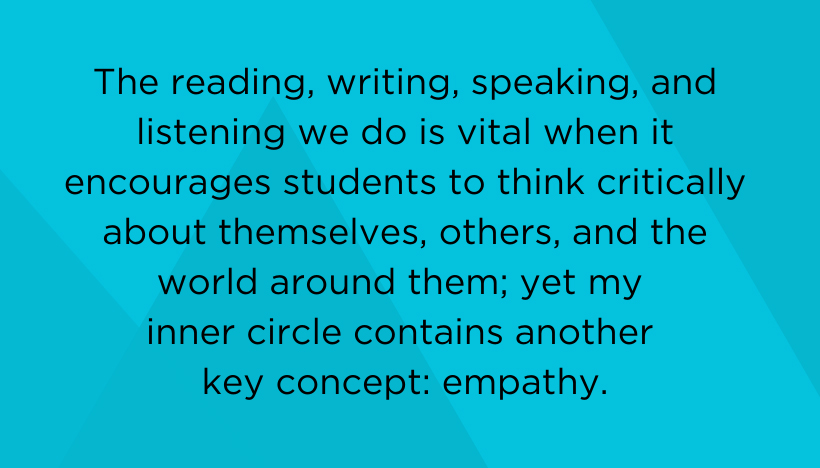This post was written by NCTE Ambassador Lindsay Schneider.
What is imperative for students to know? What is important for students to know? What is nice for students to know? These are the three simple questions that guide my curriculum planning.
In a time when teachers are bombarded with district pacing guides, new trends in education, and a plethora of literacies to teach, it is easy to get lost and lose sight of what is best for students. As teachers, we can quickly get burnt out or overwhelmed when we see the endless lists of what “should” be accomplished each day, each week, and each year.
For myself, I have learned the best way to ameliorate this is by going back to the basics I was taught in my teacher licensure program. At the beginning of each new class, I create three concentric circles: in the innermost circle, I note what I believe is imperative for students to know and be able to do; in the middle circle, I note what is important for students to know and be able to do; finally, in the outermost circle, I note what is nice for students to know and be able to do.
This simple graphic organizer focuses me on what I value most in my classroom and helps me align all my other choices in my classroom with a clear sense of purpose.
As I get further into my teaching career, I notice that my inner circle stays the same: in my classroom, students must read deeply, robustly, and diversely in order to gain a better understanding of themselves, and to develop empathy for those around them; they write in ways that reflect their critical understanding of a text, not to regurgitate a list of plot events or character traits; and they work on developing their speaking and listening abilities throughout our activities.
The reading, writing, speaking, and listening we do is vital when it encourages students to think critically about themselves, others, and the world around them; yet my inner circle contains another key concept: empathy.
I believe empathy is the highest level of critical thinking.
So often we spend hours researching and creating lesson plans and activities to encourage critical thinking; we seek out rigorous texts and projects to reinforce meaningful analysis. But the highest and most important analysis we conduct as we read is empathy. Before parsing out the significance of setting, before delving into the imagery, metaphors, symbols, and motifs, we must perform a critical analysis by which we open ourselves to the lives, feelings, and experiences of others.
Through critical thinking, writing, reading, and re-reading, we analyze texts and authors’ craft in order to both gain empathy for lives we have not lived and for experiences we have not had, all while meeting a new character whom we come to care for deeply.
This work not only bolsters our students academic skills but teaches students in ways that extend far beyond the classroom and our short time together. For “every time I read a book like me, I diminish. Every time I read a book with characters not like me, I grow more than I ever thought possible” (Kylene Beers, NCTE 2019).
If the central goal in my classroom is for students to develop critical thinking skills which afford them insight into the world beyond their own understanding of it, my work and my mission is clear. If the central goal in my classroom is for students to read robustly and to read consciously in a way that stimulates empathetic imagination and action, my work and my mission is vital.
How fortunate we are to have a role in schools that allows us to select texts in which students can find themselves and gain an understanding of others! How intimidating it can be to have a role that encourages us to select texts in which students can find themselves and gain an understanding of others!
My mission is clear and vital: to design a curriculum filled with diverse protagonists, settings, and conflicts as well as curate a classroom library overflowing with books that serve as mirrors, windows, and sliding glass doors.
We cannot teach students simply to read, but rather to READ (Randy Ribay, ALAN 2019); we must teach students to read with a critical eye, an open heart, and hands that are moved to action. We, too, must read this way, and more robustly than ever before.
Critical analysis takes many forms: understanding characterization, scanning lines of poetry for meter and effect, creating and substantiating arguments, and articulating meaning throughout an entire text. Yet the highest form in critical thinking is an empathy that doesn’t just read the words on a page but rather truly sees, hears, and act upon a world beyond ourselves.

Lindsay Schneider teaches senior and freshman English in North Carolina. She is an avid reader and aspiring writer who is passionate about all things related to YA lit, building life-long readers beyond the walls of the classroom, integrating the arts into the English classroom, good coffee, baking, and the Wake Forest Demon Deacons. She is honored to serve as an NCTE Community Ambassador.

